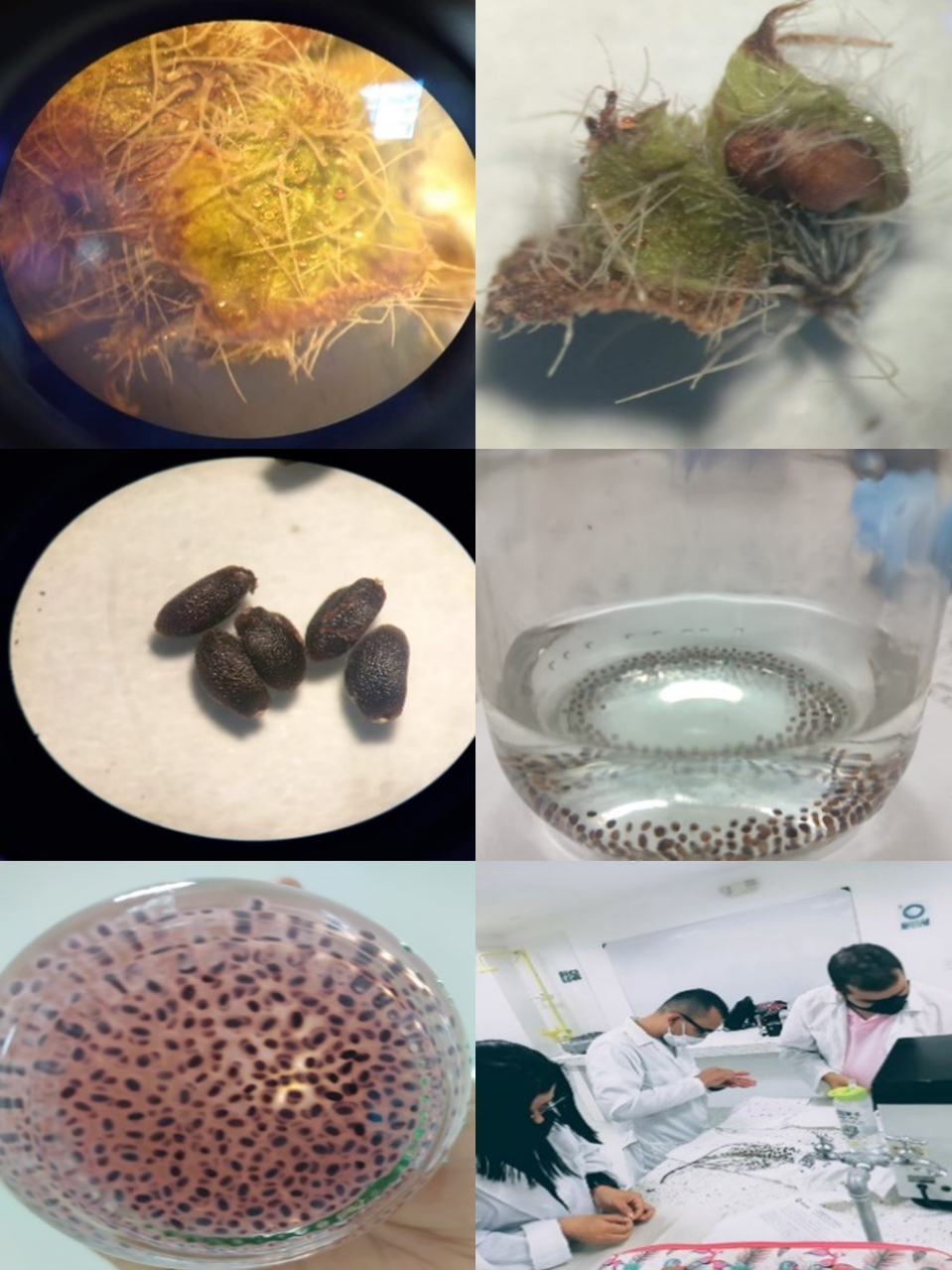Evaluation of different disinfection protocols for seed germination of Ocimum basilicum L.
DOI:
https://doi.org/10.54502/msuceva.v3n2a8Palabras clave:
Aromatic plant, basil, dormancy, in vitro culture, micropropagationResumen
The aim of this study was to discriminate between different disinfection protocols applied to common basil seeds for in vitro establishment on Murashige & Skoog medium. The aim of this approach was not only to overcome seed dormancy, but also to decisively influence the germination process in order to achieve a significant increase in the proportion of seeds that germinate successfully. In the Colombian context, where some 156 species of medicinal plants are currently marketed, basil (Ocimum basilicum L.), originally from Asia Minor, stands out as one of the most widely used plants in the world. In the department of Valle del Cauca, medicinal plants have emerged as protagonists in contrast to the monoculture of sugar cane (Saccharum Officinarum L.) that dominates the region. However, basil faces significant challenges related to seed dormancy, a condition that negatively affects germination and therefore directly affects yield. In this scenario, 21 treatments were carried out in the Biological Sciences Laboratory of the Central Unit of Valle del Cauca, which showed a marked variability and influence in phenological development, especially in stem and leaf growth. Treatment 12 (0.7% NaClO) showed the highest percentage of basil seed germination (80%). It is imperative to explore new protocols that effectively contribute to the basil production process by overcoming seed dormancy.
Descargas
Métricas
Citas
Pájaro-González Y, Oliveros-Díaz AF, Cabrera-Barraza J, Cerra-Dominguez J, Díaz-Castillo F. A review of medicinal plants used as antimicrobials in Colombia. Medicinal Plants as Anti-Infectives: Current Knowledge and New Perspectives 2022:3–57. https://doi.org/10.1016/B978-0-323-90999-0.00005-7 DOI: https://doi.org/10.1016/B978-0-323-90999-0.00005-7
Marmolejo Liloy M, Ponce Mendoza JD, Hinestroza Córdoba LI, Moreno Holguín H. An ethnobotanical survey of spice, aromatic and medicinal plants used in La Molana, Atrato-Choco, Colombia: Basis for biodiversity conservation. Acta Agron 2018;67:9–16.
https://doi.org/10.15446/acag.v67n1.59316 DOI: https://doi.org/10.15446/acag.v67n1.59316
Shahrajabian MH, Sun W, Cheng Q. Chemical components and pharmacological benefits of Basil (Ocimum basilicum L.): a review. Int J Food Prop 2020;23:1961–70. https://doi.org/10.1080/10942912.2020.1828456 DOI: https://doi.org/10.1080/10942912.2020.1828456
Filip S. Basil (Ocimum basilicum L.) a Source of Valuable Phytonutrients. International Journal of Clinical Nutrition & Dietetics 2017;3. https://doi.org/10.15344/2456-8171/2017/118 DOI: https://doi.org/10.15344/2456-8171/2017/118
Lal RK. Breeding for new chemotypes with stable high essential oil yield in Ocimum. Ind Crops Prod 2014; 59:41–9.
https://doi.org/10.1016/J.INDCROP.2014.04.047 DOI: https://doi.org/10.1016/j.indcrop.2014.04.047
Marotti M, Piccaglia R, Giovanelli E. Differences in Essential Oil Composition of Basil (Ocimum basilicum L.) Italian Cultivars Related to Morphological Characteristics. J Agric Food Chem 1996; 44:3926–9. https://doi.org/10.1021/jf9601067 DOI: https://doi.org/10.1021/jf9601067
Beltrán Cifuentes M, Cantillo Maldonado M, Vivas Castaño A. Actividad antibacteriana de los aceites obtenidos de Ocimum basilicum L. var. cinammom, O. album, O. thyrsiflorum, para uso potencial en fitocosmética. Investigaciones Andina 2013; 15:798–810.
http://scielo.org.co/pdf/inan/v15n27/v15n27a07.pdf.
Nazir S, Wani IA. Functional characterization of basil (Ocimum basilicum L.) seed mucilage. Bioactive carbohydrates and dietary fibre 2021; 25:100261. https://doi.org/10.1016/j.bcdf.2021.100261 DOI: https://doi.org/10.1016/j.bcdf.2021.100261
Jirovetz L, Buchbauer G, Shafi MP, Kaniampady MM. Chemotaxonomical analysis of the essential oil aroma compounds of four different Ocimum species from southern India. European Food Research and Technology 2003; 217:120–4. https://doi.org/10.1007/s00217-003-0708-1 DOI: https://doi.org/10.1007/s00217-003-0708-1
Klimánková E, Holadová K, Hajšlová J, Čajka T, Poustka J, Koudela M. Aroma profiles of five basil (Ocimum basilicum L.) cultivars grown under conventional and organic conditions. Food Chem 2008; 107:464–72. https://doi.org/10.1016/j.foodchem.2007.07.062 DOI: https://doi.org/10.1016/j.foodchem.2007.07.062
Sánchez Orozco MS, Durán Gaviria LA, Castro Vargas DF, Bonilla Correa CR. Calidad fisiológica de semillas de cinco variedades de Albahaca Ocimum spp. en condiciones del Valle del Cauca. Acta Agron 2015;65. https://doi.org/10.15446/acag.v65n1.45377 DOI: https://doi.org/10.15446/acag.v65n1.45377
Díaz Merchán J. Caracterización del mercado colombiano de plantas medicinales y aromáticas. Informe técnico. Bogotá, DC: 2003. http://repository.humboldt.org.co/handle/20.500.11761/32544?show=full
Chung I, Ryu H, Yoon S-Y, Ha JC. Health effects of sodium hypochlorite: review of published case reports. Environ Anal Health Toxicol 2022;37:e2022006. https://doi.org/10.5620/eaht.2022006 DOI: https://doi.org/10.5620/eaht.2022006
Bedoya Pérez JC, Sánchez Jaramillo CY, Bermúdez Gómez SM, Restrepo SR. Estandarización de un protocolo de desinfección y establecimiento de cultivo in vitro de Aloysia tryphilla. Biotecnología En El Sector Agropecuario y Agroindustrial 2016;14:38.
https://doi.org/10.18684/BSAA(14)38-46 DOI: https://doi.org/10.18684/BSAA(14)38-46
Espinosa-Leal CA, Puente-Garza CA, García-Lara S. In vitro plant tissue culture: means for production of biological active compounds. Planta 2018; 248:1–18. https://doi.org/10.1007/s00425-018-2910-1 DOI: https://doi.org/10.1007/s00425-018-2910-1
Barreto R, Barrois B, Lambert J, Malhotra-Kumar S, Santos-Fernandes V, Monstrey S. Addressing the challenges in antisepsis: focus on povidone iodine. Int J Antimicrob Agents 2020; 56:106064. https://doi.org/10.1016/J.IJANTIMICAG.2020.106064 DOI: https://doi.org/10.1016/j.ijantimicag.2020.106064
Durani P, Leaper D. Povidone–iodine: use in hand disinfection, skin preparation and antiseptic irrigation. Int Wound J 2008; 5:376–87. https://doi.org/10.1111/j.1742-481X.2007.00405.x DOI: https://doi.org/10.1111/j.1742-481X.2007.00405.x
Eggers M. Infectious Disease Management and Control with Povidone Iodine. Infect Dis Ther 2019; 8:581–93.
https://doi.org/10.1007/s40121-019-00260-x DOI: https://doi.org/10.1007/s40121-019-00260-x

Descargas
Publicado
Cómo citar
Número
Sección
Licencia
Derechos de autor 2023 Gallego Idárraga et al.

Esta obra está bajo una licencia internacional Creative Commons Atribución-NoComercial-SinDerivadas 4.0.
Magna Scientia UCEVA proporciona un acceso abierto, libre y gratuito a su contenido, basado en el principio de que ofrecer al público un acceso libre a las investigaciones, ayuda a un mayor intercambio global del conocimiento. Lo cual, implica que los usuarios pueden leer, descargar, almacenar, imprimir, buscar, indexar y realizar enlaces a los textos completos de esta revista. Se permite distribuir los diversos artículos en las versiones post-print y oficial, sin previo permiso del autor o editor, considerando que el fin de este, no implica fines comerciales, ni la generación de obras derivadas; Solo se solicita la mención de la fuente así como la autoría. El titular del copyright será el o los autores que publiquen en Magna Scientia UCEVA.
Magna Scientia UCEVA está distribuida bajo los términos de la licencia https://creativecommons.org/licenses/by-nc-nd/4.0/deed.es




















